Economics Report: Australian Economic Analysis, Principles, and Models
VerifiedAdded on 2020/09/08
|18
|5053
|34
Report
AI Summary
This economics report examines unemployment and inflation in Australia, exploring key economic principles and models. It begins with an introduction to economics, defining the subject and its importance in decision-making for individuals, businesses, and governments. The report then delves into core economic principles, including trade-offs, opportunity costs, and incentives, as well as how people interact and how governments can influence market outcomes. Economic models, such as the Classical Economic Model and the Productivity Possibility Frontier (PPF) model, are explained and interpreted. The report further analyzes the concepts of unemployment and inflation in the Australian context, evaluating their impact on individual, business, and governmental decisions. The report concludes by assessing how market structure and macroeconomic factors influence economic outcomes, focusing on perfect competition, and the Australian economy's responses to these challenges. Finally, the report discusses the impact of these factors on the Australian economy and how different actors respond to these challenges.
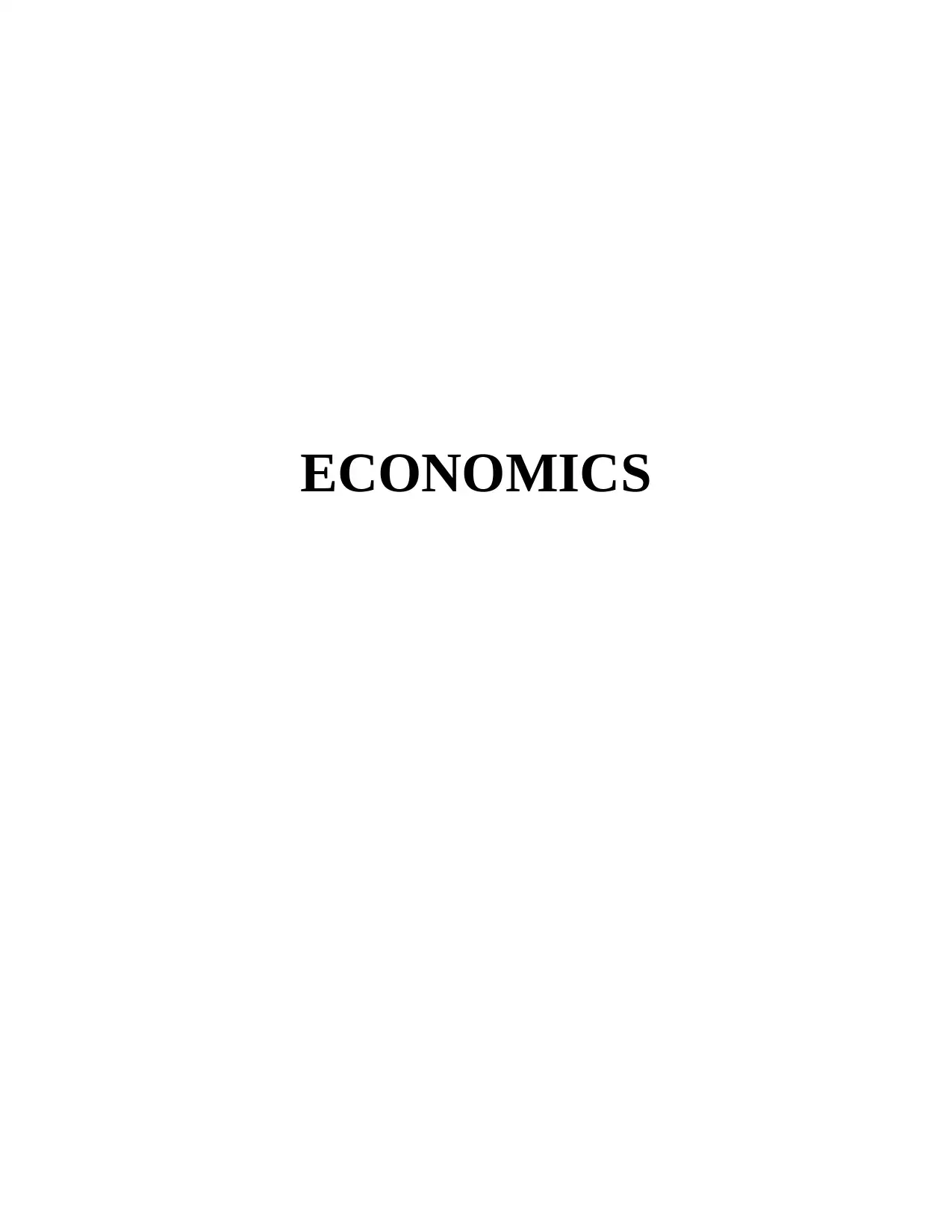
ECONOMICS
Paraphrase This Document
Need a fresh take? Get an instant paraphrase of this document with our AI Paraphraser
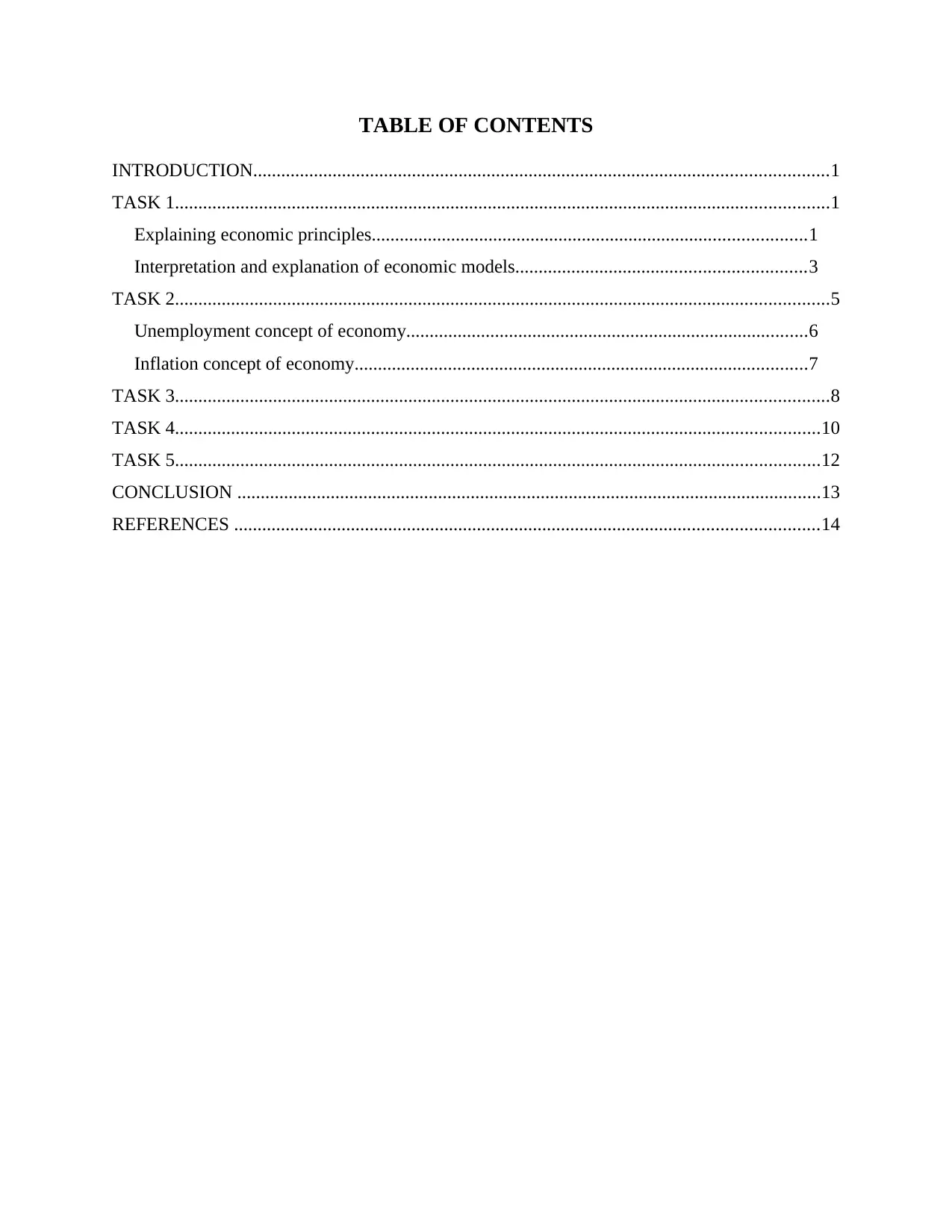
TABLE OF CONTENTS
INTRODUCTION...........................................................................................................................1
TASK 1............................................................................................................................................1
Explaining economic principles.............................................................................................1
Interpretation and explanation of economic models..............................................................3
TASK 2............................................................................................................................................5
Unemployment concept of economy......................................................................................6
Inflation concept of economy.................................................................................................7
TASK 3............................................................................................................................................8
TASK 4..........................................................................................................................................10
TASK 5..........................................................................................................................................12
CONCLUSION .............................................................................................................................13
REFERENCES .............................................................................................................................14
INTRODUCTION...........................................................................................................................1
TASK 1............................................................................................................................................1
Explaining economic principles.............................................................................................1
Interpretation and explanation of economic models..............................................................3
TASK 2............................................................................................................................................5
Unemployment concept of economy......................................................................................6
Inflation concept of economy.................................................................................................7
TASK 3............................................................................................................................................8
TASK 4..........................................................................................................................................10
TASK 5..........................................................................................................................................12
CONCLUSION .............................................................................................................................13
REFERENCES .............................................................................................................................14
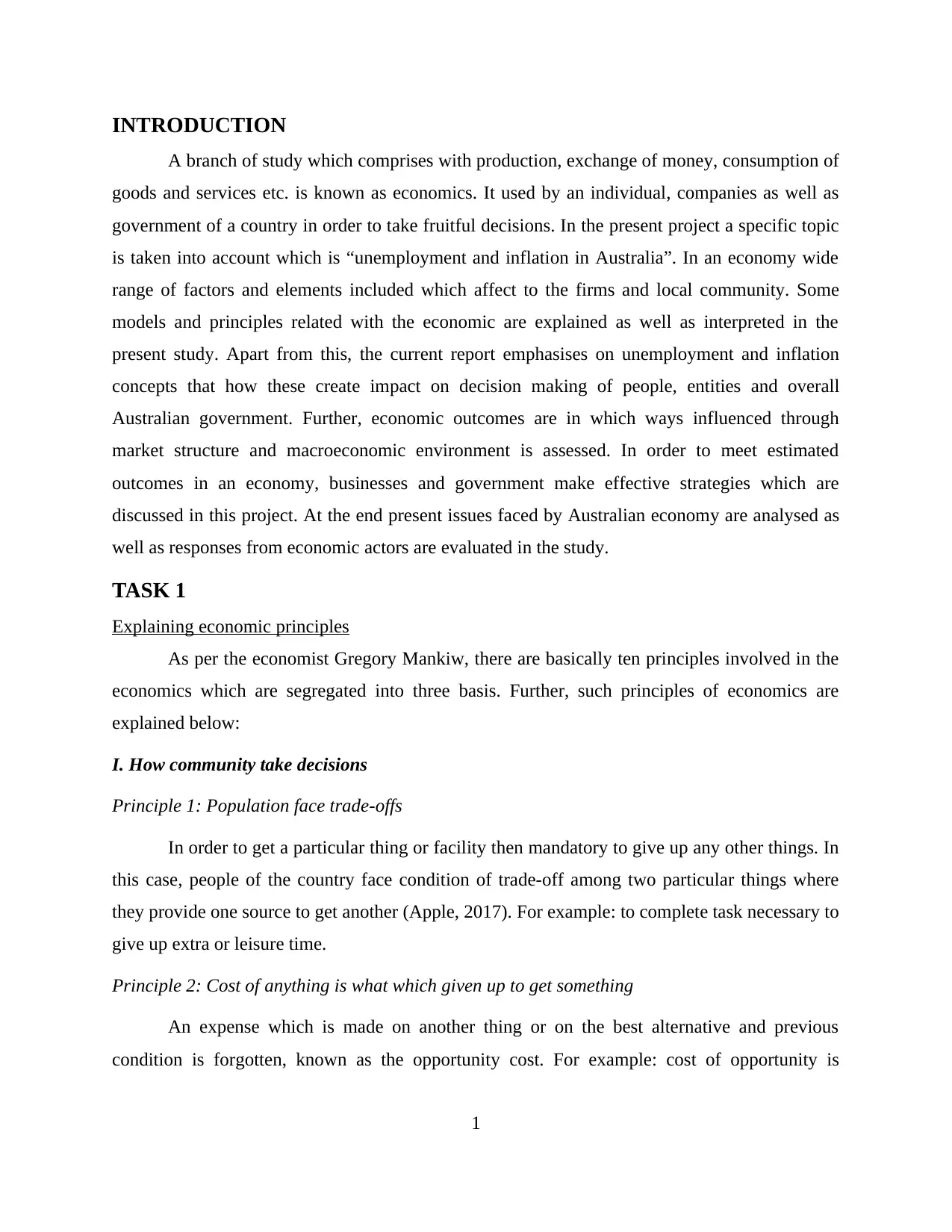
INTRODUCTION
A branch of study which comprises with production, exchange of money, consumption of
goods and services etc. is known as economics. It used by an individual, companies as well as
government of a country in order to take fruitful decisions. In the present project a specific topic
is taken into account which is “unemployment and inflation in Australia”. In an economy wide
range of factors and elements included which affect to the firms and local community. Some
models and principles related with the economic are explained as well as interpreted in the
present study. Apart from this, the current report emphasises on unemployment and inflation
concepts that how these create impact on decision making of people, entities and overall
Australian government. Further, economic outcomes are in which ways influenced through
market structure and macroeconomic environment is assessed. In order to meet estimated
outcomes in an economy, businesses and government make effective strategies which are
discussed in this project. At the end present issues faced by Australian economy are analysed as
well as responses from economic actors are evaluated in the study.
TASK 1
Explaining economic principles
As per the economist Gregory Mankiw, there are basically ten principles involved in the
economics which are segregated into three basis. Further, such principles of economics are
explained below:
I. How community take decisions
Principle 1: Population face trade-offs
In order to get a particular thing or facility then mandatory to give up any other things. In
this case, people of the country face condition of trade-off among two particular things where
they provide one source to get another (Apple, 2017). For example: to complete task necessary to
give up extra or leisure time.
Principle 2: Cost of anything is what which given up to get something
An expense which is made on another thing or on the best alternative and previous
condition is forgotten, known as the opportunity cost. For example: cost of opportunity is
1
A branch of study which comprises with production, exchange of money, consumption of
goods and services etc. is known as economics. It used by an individual, companies as well as
government of a country in order to take fruitful decisions. In the present project a specific topic
is taken into account which is “unemployment and inflation in Australia”. In an economy wide
range of factors and elements included which affect to the firms and local community. Some
models and principles related with the economic are explained as well as interpreted in the
present study. Apart from this, the current report emphasises on unemployment and inflation
concepts that how these create impact on decision making of people, entities and overall
Australian government. Further, economic outcomes are in which ways influenced through
market structure and macroeconomic environment is assessed. In order to meet estimated
outcomes in an economy, businesses and government make effective strategies which are
discussed in this project. At the end present issues faced by Australian economy are analysed as
well as responses from economic actors are evaluated in the study.
TASK 1
Explaining economic principles
As per the economist Gregory Mankiw, there are basically ten principles involved in the
economics which are segregated into three basis. Further, such principles of economics are
explained below:
I. How community take decisions
Principle 1: Population face trade-offs
In order to get a particular thing or facility then mandatory to give up any other things. In
this case, people of the country face condition of trade-off among two particular things where
they provide one source to get another (Apple, 2017). For example: to complete task necessary to
give up extra or leisure time.
Principle 2: Cost of anything is what which given up to get something
An expense which is made on another thing or on the best alternative and previous
condition is forgotten, known as the opportunity cost. For example: cost of opportunity is
1
⊘ This is a preview!⊘
Do you want full access?
Subscribe today to unlock all pages.

Trusted by 1+ million students worldwide
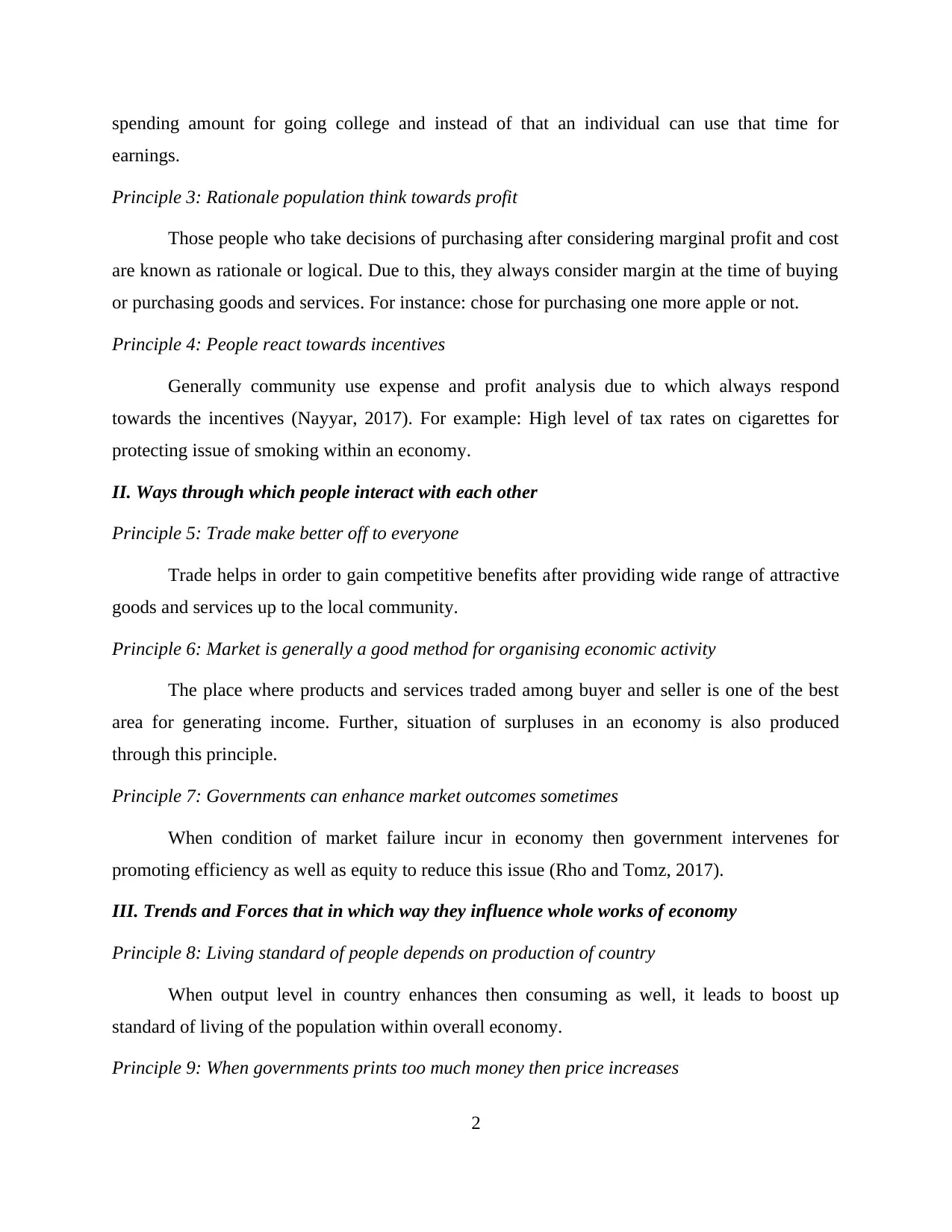
spending amount for going college and instead of that an individual can use that time for
earnings.
Principle 3: Rationale population think towards profit
Those people who take decisions of purchasing after considering marginal profit and cost
are known as rationale or logical. Due to this, they always consider margin at the time of buying
or purchasing goods and services. For instance: chose for purchasing one more apple or not.
Principle 4: People react towards incentives
Generally community use expense and profit analysis due to which always respond
towards the incentives (Nayyar, 2017). For example: High level of tax rates on cigarettes for
protecting issue of smoking within an economy.
II. Ways through which people interact with each other
Principle 5: Trade make better off to everyone
Trade helps in order to gain competitive benefits after providing wide range of attractive
goods and services up to the local community.
Principle 6: Market is generally a good method for organising economic activity
The place where products and services traded among buyer and seller is one of the best
area for generating income. Further, situation of surpluses in an economy is also produced
through this principle.
Principle 7: Governments can enhance market outcomes sometimes
When condition of market failure incur in economy then government intervenes for
promoting efficiency as well as equity to reduce this issue (Rho and Tomz, 2017).
III. Trends and Forces that in which way they influence whole works of economy
Principle 8: Living standard of people depends on production of country
When output level in country enhances then consuming as well, it leads to boost up
standard of living of the population within overall economy.
Principle 9: When governments prints too much money then price increases
2
earnings.
Principle 3: Rationale population think towards profit
Those people who take decisions of purchasing after considering marginal profit and cost
are known as rationale or logical. Due to this, they always consider margin at the time of buying
or purchasing goods and services. For instance: chose for purchasing one more apple or not.
Principle 4: People react towards incentives
Generally community use expense and profit analysis due to which always respond
towards the incentives (Nayyar, 2017). For example: High level of tax rates on cigarettes for
protecting issue of smoking within an economy.
II. Ways through which people interact with each other
Principle 5: Trade make better off to everyone
Trade helps in order to gain competitive benefits after providing wide range of attractive
goods and services up to the local community.
Principle 6: Market is generally a good method for organising economic activity
The place where products and services traded among buyer and seller is one of the best
area for generating income. Further, situation of surpluses in an economy is also produced
through this principle.
Principle 7: Governments can enhance market outcomes sometimes
When condition of market failure incur in economy then government intervenes for
promoting efficiency as well as equity to reduce this issue (Rho and Tomz, 2017).
III. Trends and Forces that in which way they influence whole works of economy
Principle 8: Living standard of people depends on production of country
When output level in country enhances then consuming as well, it leads to boost up
standard of living of the population within overall economy.
Principle 9: When governments prints too much money then price increases
2
Paraphrase This Document
Need a fresh take? Get an instant paraphrase of this document with our AI Paraphraser
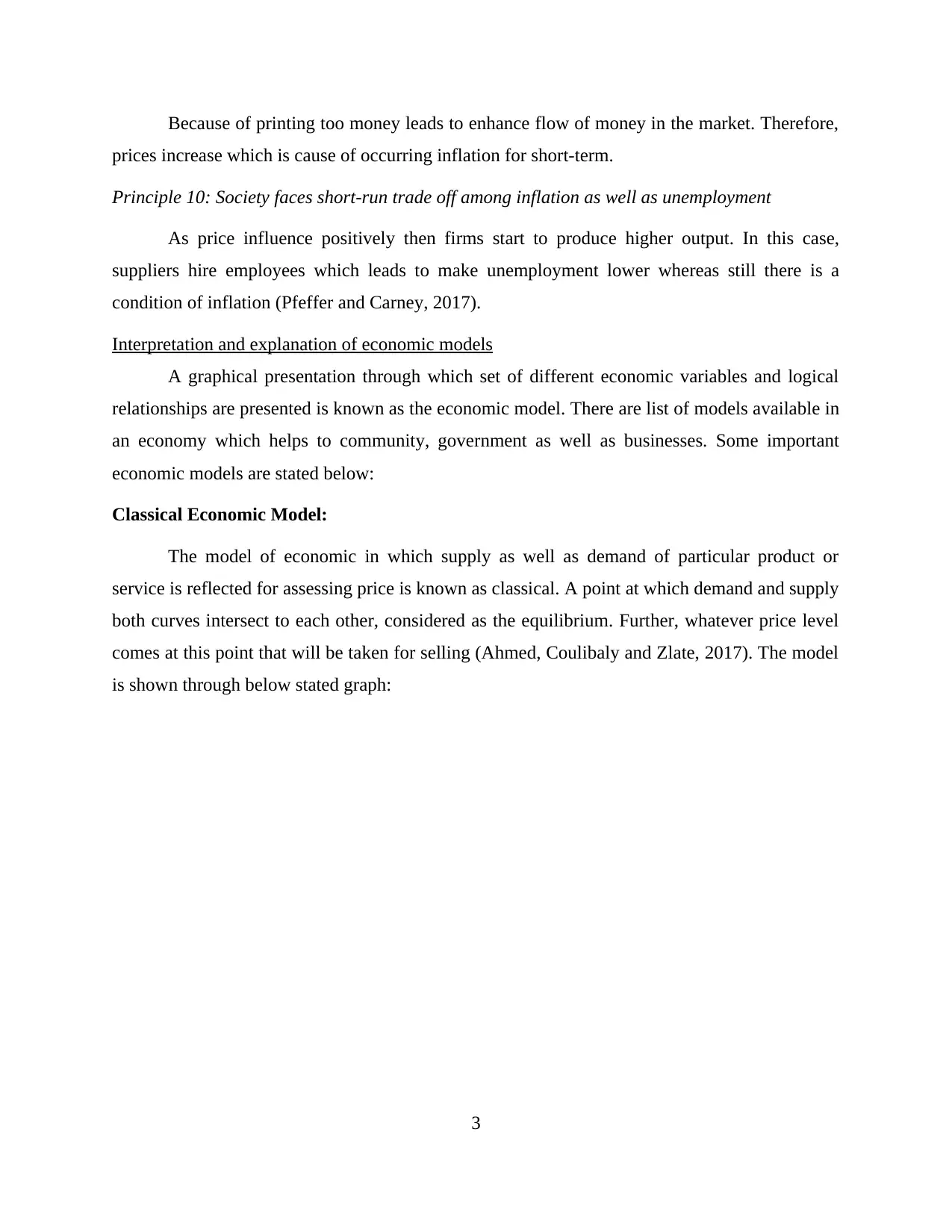
Because of printing too money leads to enhance flow of money in the market. Therefore,
prices increase which is cause of occurring inflation for short-term.
Principle 10: Society faces short-run trade off among inflation as well as unemployment
As price influence positively then firms start to produce higher output. In this case,
suppliers hire employees which leads to make unemployment lower whereas still there is a
condition of inflation (Pfeffer and Carney, 2017).
Interpretation and explanation of economic models
A graphical presentation through which set of different economic variables and logical
relationships are presented is known as the economic model. There are list of models available in
an economy which helps to community, government as well as businesses. Some important
economic models are stated below:
Classical Economic Model:
The model of economic in which supply as well as demand of particular product or
service is reflected for assessing price is known as classical. A point at which demand and supply
both curves intersect to each other, considered as the equilibrium. Further, whatever price level
comes at this point that will be taken for selling (Ahmed, Coulibaly and Zlate, 2017). The model
is shown through below stated graph:
3
prices increase which is cause of occurring inflation for short-term.
Principle 10: Society faces short-run trade off among inflation as well as unemployment
As price influence positively then firms start to produce higher output. In this case,
suppliers hire employees which leads to make unemployment lower whereas still there is a
condition of inflation (Pfeffer and Carney, 2017).
Interpretation and explanation of economic models
A graphical presentation through which set of different economic variables and logical
relationships are presented is known as the economic model. There are list of models available in
an economy which helps to community, government as well as businesses. Some important
economic models are stated below:
Classical Economic Model:
The model of economic in which supply as well as demand of particular product or
service is reflected for assessing price is known as classical. A point at which demand and supply
both curves intersect to each other, considered as the equilibrium. Further, whatever price level
comes at this point that will be taken for selling (Ahmed, Coulibaly and Zlate, 2017). The model
is shown through below stated graph:
3
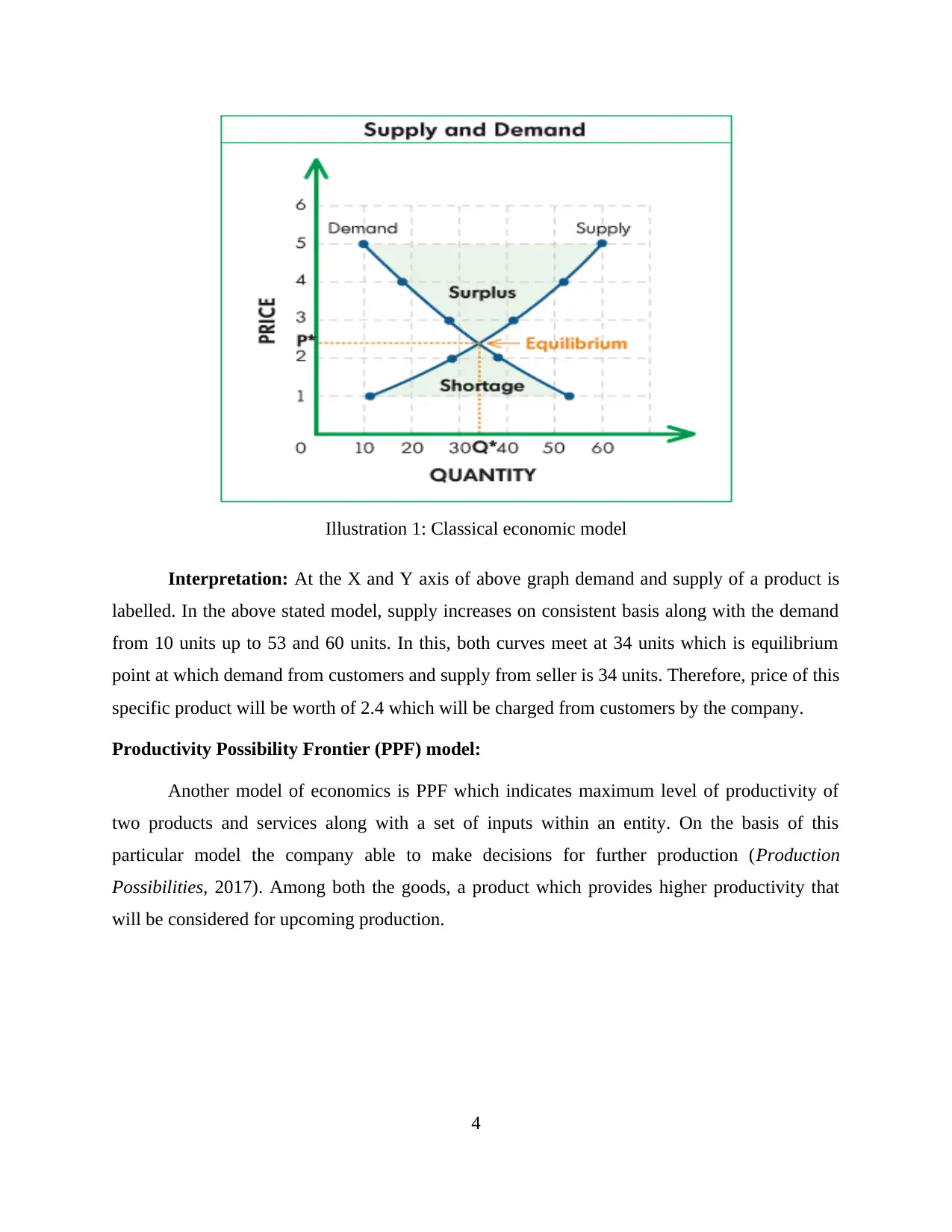
Illustration 1: Classical economic model
Interpretation: At the X and Y axis of above graph demand and supply of a product is
labelled. In the above stated model, supply increases on consistent basis along with the demand
from 10 units up to 53 and 60 units. In this, both curves meet at 34 units which is equilibrium
point at which demand from customers and supply from seller is 34 units. Therefore, price of this
specific product will be worth of 2.4 which will be charged from customers by the company.
Productivity Possibility Frontier (PPF) model:
Another model of economics is PPF which indicates maximum level of productivity of
two products and services along with a set of inputs within an entity. On the basis of this
particular model the company able to make decisions for further production (Production
Possibilities, 2017). Among both the goods, a product which provides higher productivity that
will be considered for upcoming production.
4
Interpretation: At the X and Y axis of above graph demand and supply of a product is
labelled. In the above stated model, supply increases on consistent basis along with the demand
from 10 units up to 53 and 60 units. In this, both curves meet at 34 units which is equilibrium
point at which demand from customers and supply from seller is 34 units. Therefore, price of this
specific product will be worth of 2.4 which will be charged from customers by the company.
Productivity Possibility Frontier (PPF) model:
Another model of economics is PPF which indicates maximum level of productivity of
two products and services along with a set of inputs within an entity. On the basis of this
particular model the company able to make decisions for further production (Production
Possibilities, 2017). Among both the goods, a product which provides higher productivity that
will be considered for upcoming production.
4
⊘ This is a preview!⊘
Do you want full access?
Subscribe today to unlock all pages.

Trusted by 1+ million students worldwide
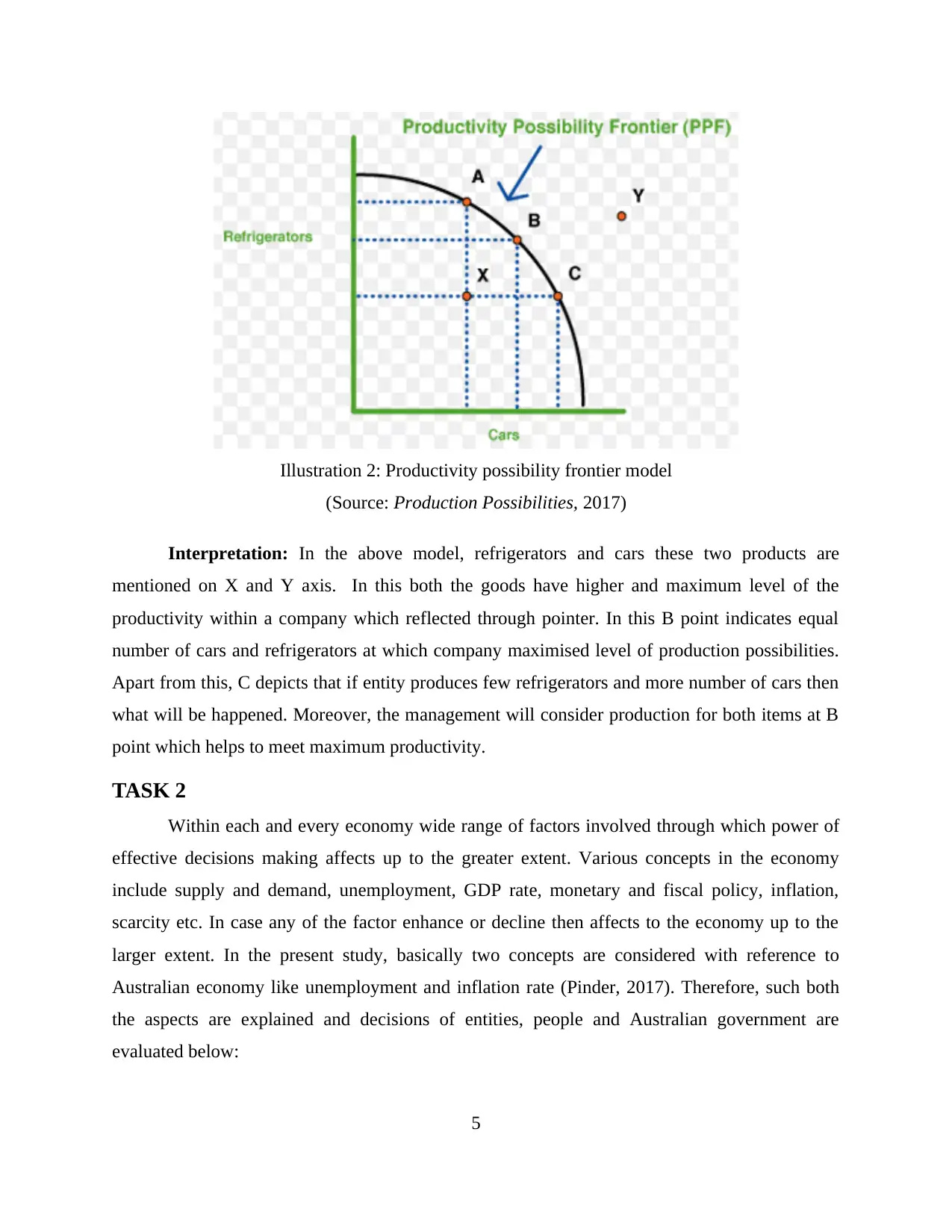
Illustration 2: Productivity possibility frontier model
(Source: Production Possibilities, 2017)
Interpretation: In the above model, refrigerators and cars these two products are
mentioned on X and Y axis. In this both the goods have higher and maximum level of the
productivity within a company which reflected through pointer. In this B point indicates equal
number of cars and refrigerators at which company maximised level of production possibilities.
Apart from this, C depicts that if entity produces few refrigerators and more number of cars then
what will be happened. Moreover, the management will consider production for both items at B
point which helps to meet maximum productivity.
TASK 2
Within each and every economy wide range of factors involved through which power of
effective decisions making affects up to the greater extent. Various concepts in the economy
include supply and demand, unemployment, GDP rate, monetary and fiscal policy, inflation,
scarcity etc. In case any of the factor enhance or decline then affects to the economy up to the
larger extent. In the present study, basically two concepts are considered with reference to
Australian economy like unemployment and inflation rate (Pinder, 2017). Therefore, such both
the aspects are explained and decisions of entities, people and Australian government are
evaluated below:
5
(Source: Production Possibilities, 2017)
Interpretation: In the above model, refrigerators and cars these two products are
mentioned on X and Y axis. In this both the goods have higher and maximum level of the
productivity within a company which reflected through pointer. In this B point indicates equal
number of cars and refrigerators at which company maximised level of production possibilities.
Apart from this, C depicts that if entity produces few refrigerators and more number of cars then
what will be happened. Moreover, the management will consider production for both items at B
point which helps to meet maximum productivity.
TASK 2
Within each and every economy wide range of factors involved through which power of
effective decisions making affects up to the greater extent. Various concepts in the economy
include supply and demand, unemployment, GDP rate, monetary and fiscal policy, inflation,
scarcity etc. In case any of the factor enhance or decline then affects to the economy up to the
larger extent. In the present study, basically two concepts are considered with reference to
Australian economy like unemployment and inflation rate (Pinder, 2017). Therefore, such both
the aspects are explained and decisions of entities, people and Australian government are
evaluated below:
5
Paraphrase This Document
Need a fresh take? Get an instant paraphrase of this document with our AI Paraphraser
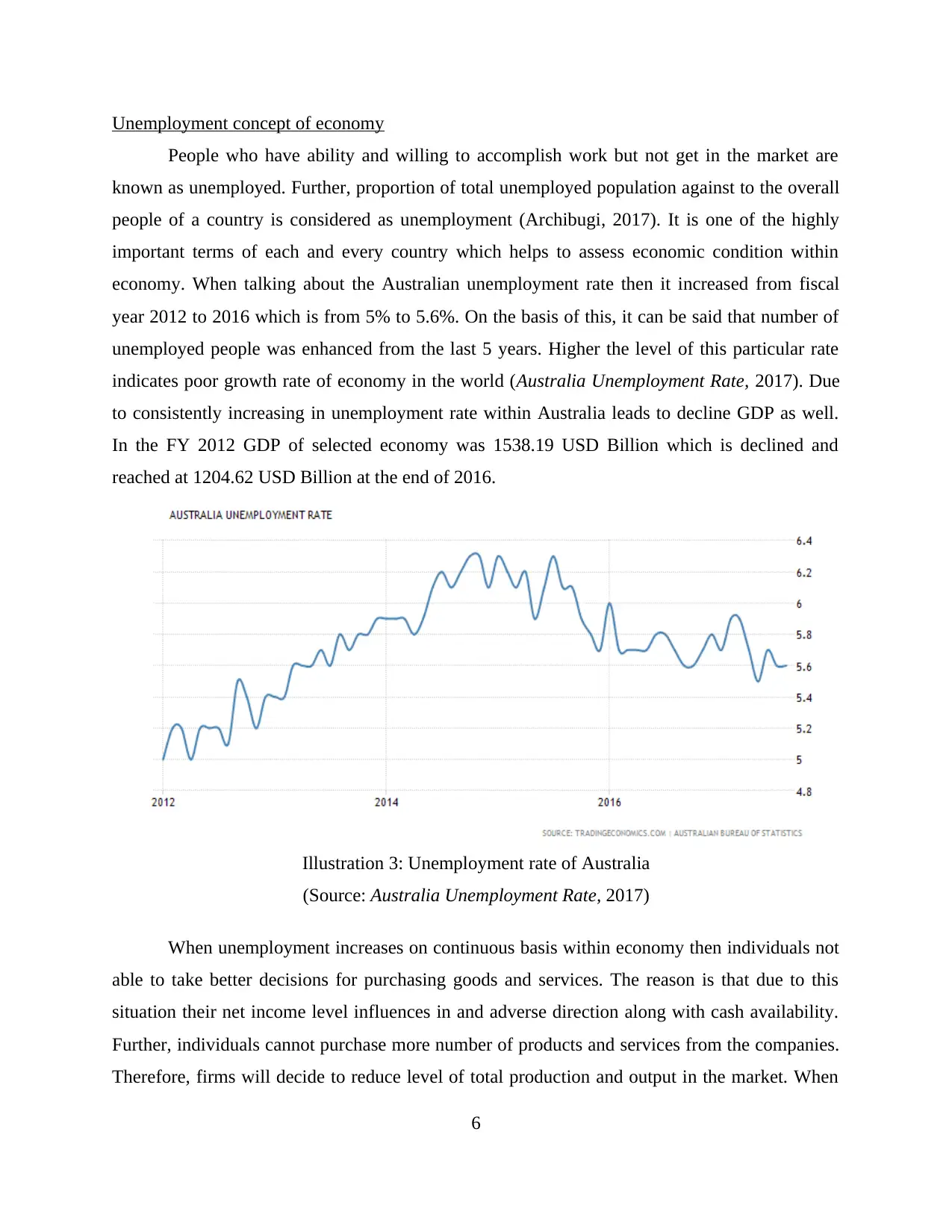
Unemployment concept of economy
People who have ability and willing to accomplish work but not get in the market are
known as unemployed. Further, proportion of total unemployed population against to the overall
people of a country is considered as unemployment (Archibugi, 2017). It is one of the highly
important terms of each and every country which helps to assess economic condition within
economy. When talking about the Australian unemployment rate then it increased from fiscal
year 2012 to 2016 which is from 5% to 5.6%. On the basis of this, it can be said that number of
unemployed people was enhanced from the last 5 years. Higher the level of this particular rate
indicates poor growth rate of economy in the world (Australia Unemployment Rate, 2017). Due
to consistently increasing in unemployment rate within Australia leads to decline GDP as well.
In the FY 2012 GDP of selected economy was 1538.19 USD Billion which is declined and
reached at 1204.62 USD Billion at the end of 2016.
Illustration 3: Unemployment rate of Australia
(Source: Australia Unemployment Rate, 2017)
When unemployment increases on continuous basis within economy then individuals not
able to take better decisions for purchasing goods and services. The reason is that due to this
situation their net income level influences in and adverse direction along with cash availability.
Further, individuals cannot purchase more number of products and services from the companies.
Therefore, firms will decide to reduce level of total production and output in the market. When
6
People who have ability and willing to accomplish work but not get in the market are
known as unemployed. Further, proportion of total unemployed population against to the overall
people of a country is considered as unemployment (Archibugi, 2017). It is one of the highly
important terms of each and every country which helps to assess economic condition within
economy. When talking about the Australian unemployment rate then it increased from fiscal
year 2012 to 2016 which is from 5% to 5.6%. On the basis of this, it can be said that number of
unemployed people was enhanced from the last 5 years. Higher the level of this particular rate
indicates poor growth rate of economy in the world (Australia Unemployment Rate, 2017). Due
to consistently increasing in unemployment rate within Australia leads to decline GDP as well.
In the FY 2012 GDP of selected economy was 1538.19 USD Billion which is declined and
reached at 1204.62 USD Billion at the end of 2016.
Illustration 3: Unemployment rate of Australia
(Source: Australia Unemployment Rate, 2017)
When unemployment increases on continuous basis within economy then individuals not
able to take better decisions for purchasing goods and services. The reason is that due to this
situation their net income level influences in and adverse direction along with cash availability.
Further, individuals cannot purchase more number of products and services from the companies.
Therefore, firms will decide to reduce level of total production and output in the market. When
6
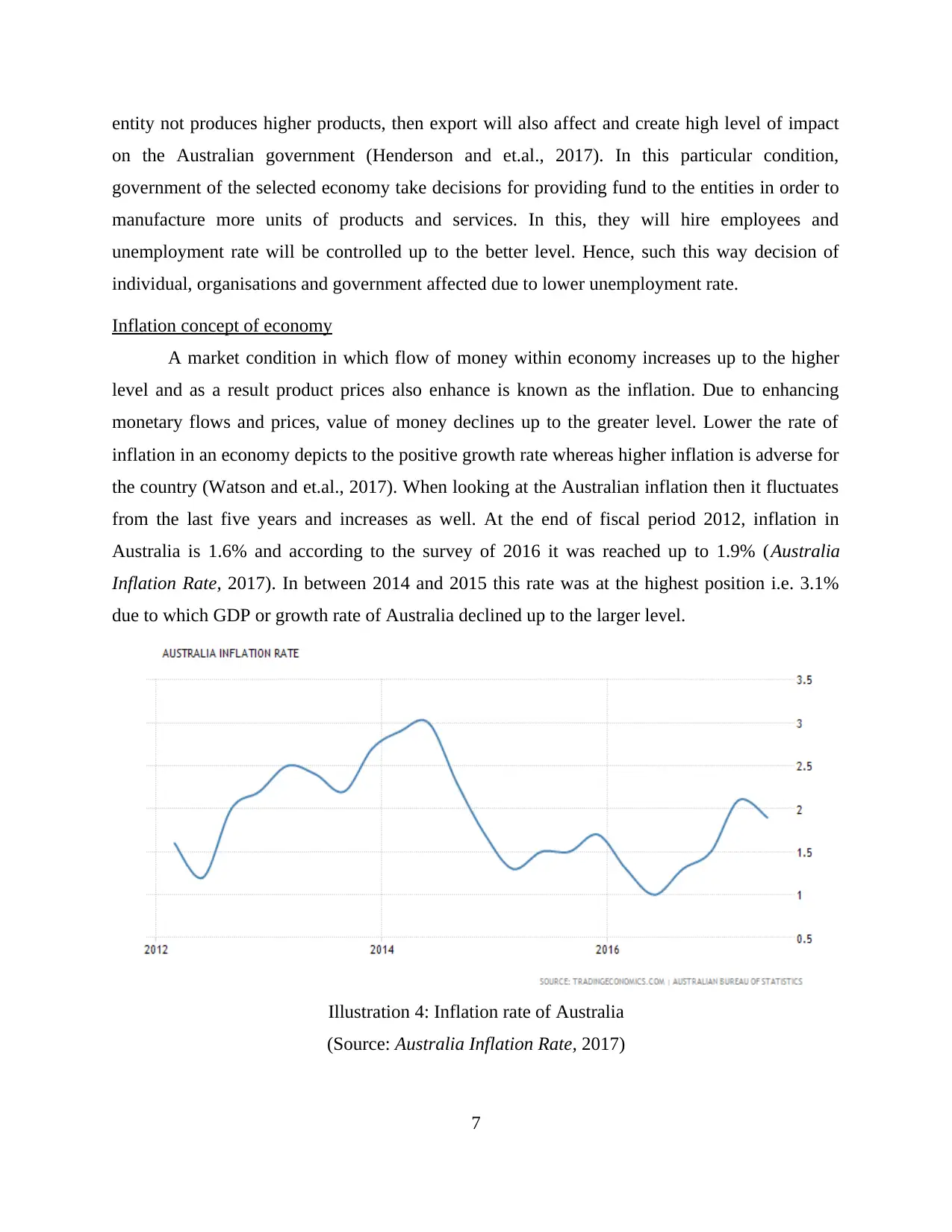
entity not produces higher products, then export will also affect and create high level of impact
on the Australian government (Henderson and et.al., 2017). In this particular condition,
government of the selected economy take decisions for providing fund to the entities in order to
manufacture more units of products and services. In this, they will hire employees and
unemployment rate will be controlled up to the better level. Hence, such this way decision of
individual, organisations and government affected due to lower unemployment rate.
Inflation concept of economy
A market condition in which flow of money within economy increases up to the higher
level and as a result product prices also enhance is known as the inflation. Due to enhancing
monetary flows and prices, value of money declines up to the greater level. Lower the rate of
inflation in an economy depicts to the positive growth rate whereas higher inflation is adverse for
the country (Watson and et.al., 2017). When looking at the Australian inflation then it fluctuates
from the last five years and increases as well. At the end of fiscal period 2012, inflation in
Australia is 1.6% and according to the survey of 2016 it was reached up to 1.9% (Australia
Inflation Rate, 2017). In between 2014 and 2015 this rate was at the highest position i.e. 3.1%
due to which GDP or growth rate of Australia declined up to the larger level.
Illustration 4: Inflation rate of Australia
(Source: Australia Inflation Rate, 2017)
7
on the Australian government (Henderson and et.al., 2017). In this particular condition,
government of the selected economy take decisions for providing fund to the entities in order to
manufacture more units of products and services. In this, they will hire employees and
unemployment rate will be controlled up to the better level. Hence, such this way decision of
individual, organisations and government affected due to lower unemployment rate.
Inflation concept of economy
A market condition in which flow of money within economy increases up to the higher
level and as a result product prices also enhance is known as the inflation. Due to enhancing
monetary flows and prices, value of money declines up to the greater level. Lower the rate of
inflation in an economy depicts to the positive growth rate whereas higher inflation is adverse for
the country (Watson and et.al., 2017). When looking at the Australian inflation then it fluctuates
from the last five years and increases as well. At the end of fiscal period 2012, inflation in
Australia is 1.6% and according to the survey of 2016 it was reached up to 1.9% (Australia
Inflation Rate, 2017). In between 2014 and 2015 this rate was at the highest position i.e. 3.1%
due to which GDP or growth rate of Australia declined up to the larger level.
Illustration 4: Inflation rate of Australia
(Source: Australia Inflation Rate, 2017)
7
⊘ This is a preview!⊘
Do you want full access?
Subscribe today to unlock all pages.

Trusted by 1+ million students worldwide
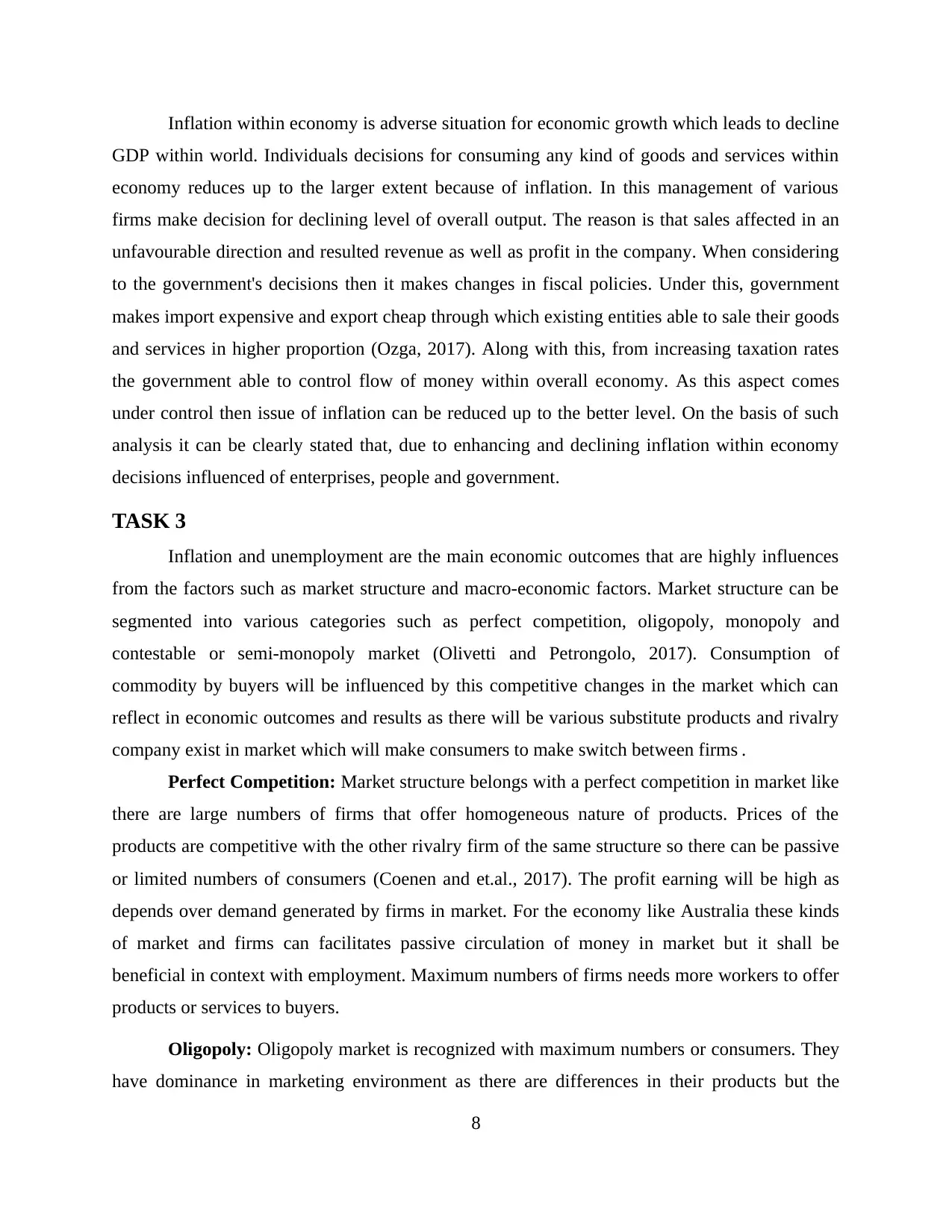
Inflation within economy is adverse situation for economic growth which leads to decline
GDP within world. Individuals decisions for consuming any kind of goods and services within
economy reduces up to the larger extent because of inflation. In this management of various
firms make decision for declining level of overall output. The reason is that sales affected in an
unfavourable direction and resulted revenue as well as profit in the company. When considering
to the government's decisions then it makes changes in fiscal policies. Under this, government
makes import expensive and export cheap through which existing entities able to sale their goods
and services in higher proportion (Ozga, 2017). Along with this, from increasing taxation rates
the government able to control flow of money within overall economy. As this aspect comes
under control then issue of inflation can be reduced up to the better level. On the basis of such
analysis it can be clearly stated that, due to enhancing and declining inflation within economy
decisions influenced of enterprises, people and government.
TASK 3
Inflation and unemployment are the main economic outcomes that are highly influences
from the factors such as market structure and macro-economic factors. Market structure can be
segmented into various categories such as perfect competition, oligopoly, monopoly and
contestable or semi-monopoly market (Olivetti and Petrongolo, 2017). Consumption of
commodity by buyers will be influenced by this competitive changes in the market which can
reflect in economic outcomes and results as there will be various substitute products and rivalry
company exist in market which will make consumers to make switch between firms .
Perfect Competition: Market structure belongs with a perfect competition in market like
there are large numbers of firms that offer homogeneous nature of products. Prices of the
products are competitive with the other rivalry firm of the same structure so there can be passive
or limited numbers of consumers (Coenen and et.al., 2017). The profit earning will be high as
depends over demand generated by firms in market. For the economy like Australia these kinds
of market and firms can facilitates passive circulation of money in market but it shall be
beneficial in context with employment. Maximum numbers of firms needs more workers to offer
products or services to buyers.
Oligopoly: Oligopoly market is recognized with maximum numbers or consumers. They
have dominance in marketing environment as there are differences in their products but the
8
GDP within world. Individuals decisions for consuming any kind of goods and services within
economy reduces up to the larger extent because of inflation. In this management of various
firms make decision for declining level of overall output. The reason is that sales affected in an
unfavourable direction and resulted revenue as well as profit in the company. When considering
to the government's decisions then it makes changes in fiscal policies. Under this, government
makes import expensive and export cheap through which existing entities able to sale their goods
and services in higher proportion (Ozga, 2017). Along with this, from increasing taxation rates
the government able to control flow of money within overall economy. As this aspect comes
under control then issue of inflation can be reduced up to the better level. On the basis of such
analysis it can be clearly stated that, due to enhancing and declining inflation within economy
decisions influenced of enterprises, people and government.
TASK 3
Inflation and unemployment are the main economic outcomes that are highly influences
from the factors such as market structure and macro-economic factors. Market structure can be
segmented into various categories such as perfect competition, oligopoly, monopoly and
contestable or semi-monopoly market (Olivetti and Petrongolo, 2017). Consumption of
commodity by buyers will be influenced by this competitive changes in the market which can
reflect in economic outcomes and results as there will be various substitute products and rivalry
company exist in market which will make consumers to make switch between firms .
Perfect Competition: Market structure belongs with a perfect competition in market like
there are large numbers of firms that offer homogeneous nature of products. Prices of the
products are competitive with the other rivalry firm of the same structure so there can be passive
or limited numbers of consumers (Coenen and et.al., 2017). The profit earning will be high as
depends over demand generated by firms in market. For the economy like Australia these kinds
of market and firms can facilitates passive circulation of money in market but it shall be
beneficial in context with employment. Maximum numbers of firms needs more workers to offer
products or services to buyers.
Oligopoly: Oligopoly market is recognized with maximum numbers or consumers. They
have dominance in marketing environment as there are differences in their products but the
8
Paraphrase This Document
Need a fresh take? Get an instant paraphrase of this document with our AI Paraphraser
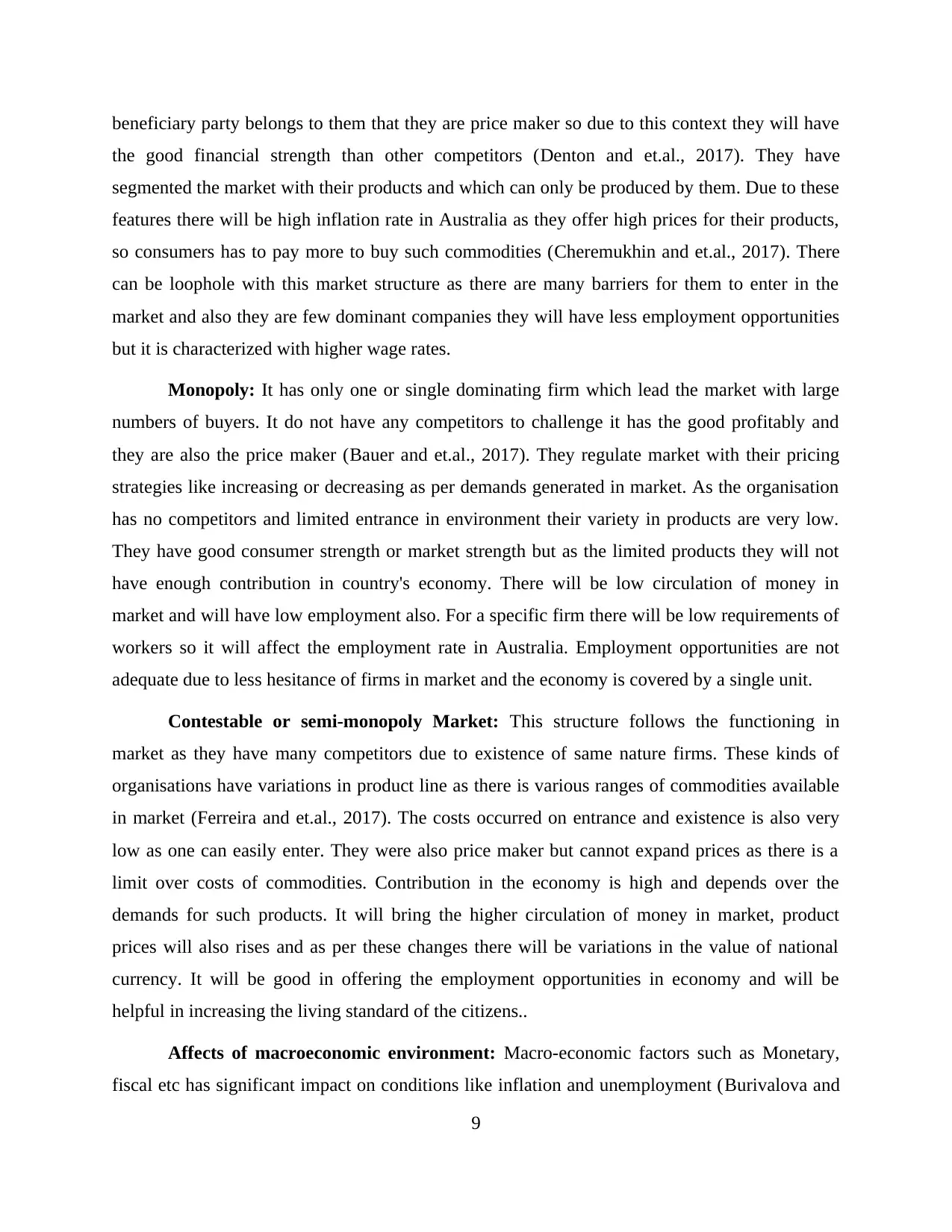
beneficiary party belongs to them that they are price maker so due to this context they will have
the good financial strength than other competitors (Denton and et.al., 2017). They have
segmented the market with their products and which can only be produced by them. Due to these
features there will be high inflation rate in Australia as they offer high prices for their products,
so consumers has to pay more to buy such commodities (Cheremukhin and et.al., 2017). There
can be loophole with this market structure as there are many barriers for them to enter in the
market and also they are few dominant companies they will have less employment opportunities
but it is characterized with higher wage rates.
Monopoly: It has only one or single dominating firm which lead the market with large
numbers of buyers. It do not have any competitors to challenge it has the good profitably and
they are also the price maker (Bauer and et.al., 2017). They regulate market with their pricing
strategies like increasing or decreasing as per demands generated in market. As the organisation
has no competitors and limited entrance in environment their variety in products are very low.
They have good consumer strength or market strength but as the limited products they will not
have enough contribution in country's economy. There will be low circulation of money in
market and will have low employment also. For a specific firm there will be low requirements of
workers so it will affect the employment rate in Australia. Employment opportunities are not
adequate due to less hesitance of firms in market and the economy is covered by a single unit.
Contestable or semi-monopoly Market: This structure follows the functioning in
market as they have many competitors due to existence of same nature firms. These kinds of
organisations have variations in product line as there is various ranges of commodities available
in market (Ferreira and et.al., 2017). The costs occurred on entrance and existence is also very
low as one can easily enter. They were also price maker but cannot expand prices as there is a
limit over costs of commodities. Contribution in the economy is high and depends over the
demands for such products. It will bring the higher circulation of money in market, product
prices will also rises and as per these changes there will be variations in the value of national
currency. It will be good in offering the employment opportunities in economy and will be
helpful in increasing the living standard of the citizens..
Affects of macroeconomic environment: Macro-economic factors such as Monetary,
fiscal etc has significant impact on conditions like inflation and unemployment (Burivalova and
9
the good financial strength than other competitors (Denton and et.al., 2017). They have
segmented the market with their products and which can only be produced by them. Due to these
features there will be high inflation rate in Australia as they offer high prices for their products,
so consumers has to pay more to buy such commodities (Cheremukhin and et.al., 2017). There
can be loophole with this market structure as there are many barriers for them to enter in the
market and also they are few dominant companies they will have less employment opportunities
but it is characterized with higher wage rates.
Monopoly: It has only one or single dominating firm which lead the market with large
numbers of buyers. It do not have any competitors to challenge it has the good profitably and
they are also the price maker (Bauer and et.al., 2017). They regulate market with their pricing
strategies like increasing or decreasing as per demands generated in market. As the organisation
has no competitors and limited entrance in environment their variety in products are very low.
They have good consumer strength or market strength but as the limited products they will not
have enough contribution in country's economy. There will be low circulation of money in
market and will have low employment also. For a specific firm there will be low requirements of
workers so it will affect the employment rate in Australia. Employment opportunities are not
adequate due to less hesitance of firms in market and the economy is covered by a single unit.
Contestable or semi-monopoly Market: This structure follows the functioning in
market as they have many competitors due to existence of same nature firms. These kinds of
organisations have variations in product line as there is various ranges of commodities available
in market (Ferreira and et.al., 2017). The costs occurred on entrance and existence is also very
low as one can easily enter. They were also price maker but cannot expand prices as there is a
limit over costs of commodities. Contribution in the economy is high and depends over the
demands for such products. It will bring the higher circulation of money in market, product
prices will also rises and as per these changes there will be variations in the value of national
currency. It will be good in offering the employment opportunities in economy and will be
helpful in increasing the living standard of the citizens..
Affects of macroeconomic environment: Macro-economic factors such as Monetary,
fiscal etc has significant impact on conditions like inflation and unemployment (Burivalova and
9
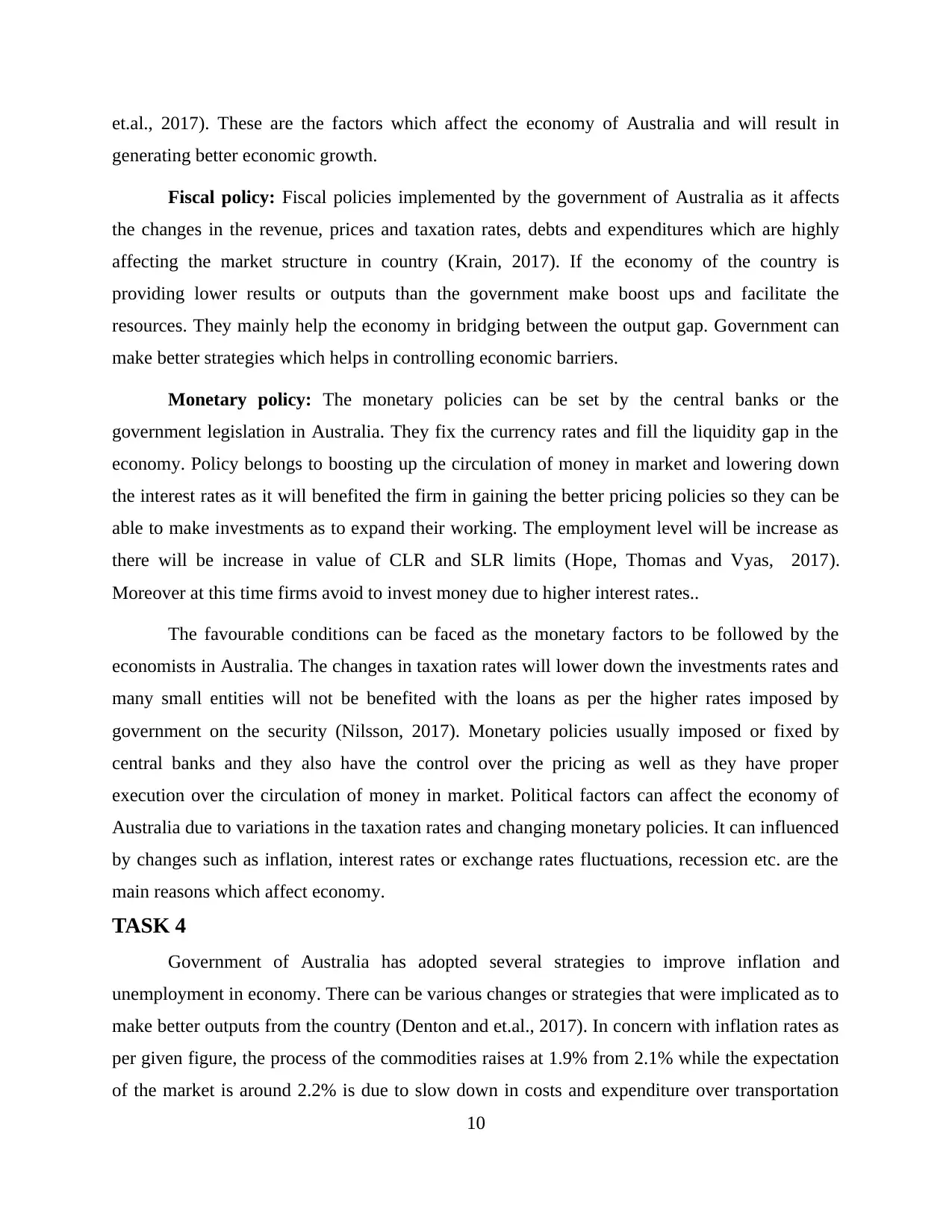
et.al., 2017). These are the factors which affect the economy of Australia and will result in
generating better economic growth.
Fiscal policy: Fiscal policies implemented by the government of Australia as it affects
the changes in the revenue, prices and taxation rates, debts and expenditures which are highly
affecting the market structure in country (Krain, 2017). If the economy of the country is
providing lower results or outputs than the government make boost ups and facilitate the
resources. They mainly help the economy in bridging between the output gap. Government can
make better strategies which helps in controlling economic barriers.
Monetary policy: The monetary policies can be set by the central banks or the
government legislation in Australia. They fix the currency rates and fill the liquidity gap in the
economy. Policy belongs to boosting up the circulation of money in market and lowering down
the interest rates as it will benefited the firm in gaining the better pricing policies so they can be
able to make investments as to expand their working. The employment level will be increase as
there will be increase in value of CLR and SLR limits (Hope, Thomas and Vyas, 2017).
Moreover at this time firms avoid to invest money due to higher interest rates..
The favourable conditions can be faced as the monetary factors to be followed by the
economists in Australia. The changes in taxation rates will lower down the investments rates and
many small entities will not be benefited with the loans as per the higher rates imposed by
government on the security (Nilsson, 2017). Monetary policies usually imposed or fixed by
central banks and they also have the control over the pricing as well as they have proper
execution over the circulation of money in market. Political factors can affect the economy of
Australia due to variations in the taxation rates and changing monetary policies. It can influenced
by changes such as inflation, interest rates or exchange rates fluctuations, recession etc. are the
main reasons which affect economy.
TASK 4
Government of Australia has adopted several strategies to improve inflation and
unemployment in economy. There can be various changes or strategies that were implicated as to
make better outputs from the country (Denton and et.al., 2017). In concern with inflation rates as
per given figure, the process of the commodities raises at 1.9% from 2.1% while the expectation
of the market is around 2.2% is due to slow down in costs and expenditure over transportation
10
generating better economic growth.
Fiscal policy: Fiscal policies implemented by the government of Australia as it affects
the changes in the revenue, prices and taxation rates, debts and expenditures which are highly
affecting the market structure in country (Krain, 2017). If the economy of the country is
providing lower results or outputs than the government make boost ups and facilitate the
resources. They mainly help the economy in bridging between the output gap. Government can
make better strategies which helps in controlling economic barriers.
Monetary policy: The monetary policies can be set by the central banks or the
government legislation in Australia. They fix the currency rates and fill the liquidity gap in the
economy. Policy belongs to boosting up the circulation of money in market and lowering down
the interest rates as it will benefited the firm in gaining the better pricing policies so they can be
able to make investments as to expand their working. The employment level will be increase as
there will be increase in value of CLR and SLR limits (Hope, Thomas and Vyas, 2017).
Moreover at this time firms avoid to invest money due to higher interest rates..
The favourable conditions can be faced as the monetary factors to be followed by the
economists in Australia. The changes in taxation rates will lower down the investments rates and
many small entities will not be benefited with the loans as per the higher rates imposed by
government on the security (Nilsson, 2017). Monetary policies usually imposed or fixed by
central banks and they also have the control over the pricing as well as they have proper
execution over the circulation of money in market. Political factors can affect the economy of
Australia due to variations in the taxation rates and changing monetary policies. It can influenced
by changes such as inflation, interest rates or exchange rates fluctuations, recession etc. are the
main reasons which affect economy.
TASK 4
Government of Australia has adopted several strategies to improve inflation and
unemployment in economy. There can be various changes or strategies that were implicated as to
make better outputs from the country (Denton and et.al., 2017). In concern with inflation rates as
per given figure, the process of the commodities raises at 1.9% from 2.1% while the expectation
of the market is around 2.2% is due to slow down in costs and expenditure over transportation
10
⊘ This is a preview!⊘
Do you want full access?
Subscribe today to unlock all pages.

Trusted by 1+ million students worldwide
1 out of 18
Related Documents
Your All-in-One AI-Powered Toolkit for Academic Success.
+13062052269
info@desklib.com
Available 24*7 on WhatsApp / Email
![[object Object]](/_next/static/media/star-bottom.7253800d.svg)
Unlock your academic potential
Copyright © 2020–2025 A2Z Services. All Rights Reserved. Developed and managed by ZUCOL.





